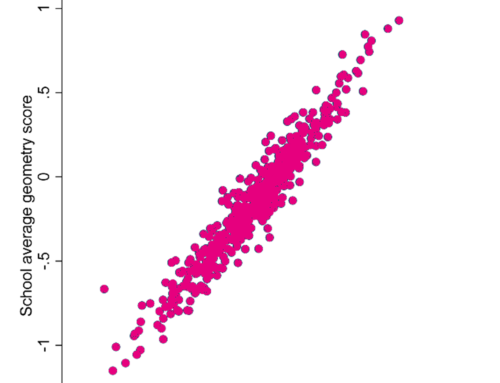For anyone trying to make sense of secondary school performance data this year, the lack of Key Stage 2 baselines presents a real problem. How can we know whether differences in attainment reflect genuine differences in outcomes, or simply differences in pupils’ starting points?
To complicate matters further, we know that both attainment and progress vary by pupil characteristics. So, both with and without baseline data, how can we make fair comparisons between groups of pupils which may have very different compositions?
In true FFT style when we’re faced with difficult questions, we think the answer lies in looking at the problem from multiple angles. That’s why we’re releasing three new measures in FFT Aspire today. Here, we’ll look at the methodology behind each, and talk through their relative strengths and weaknesses, to help you decide which are most suitable for your school or multi-academy trust.
1. CAT4-based CVA
The first measure we’re releasing provides the most comprehensive picture of performance, and will be the most familiar to regular Aspire users: contextual value-added, or CVA for short.
CVA, now available across the full suite of Key Stage 4 performance reports, shows the difference between the attainment of pupils in your school compared with pupils with similar starting points and similar characteristics[1], nationally. Starting points are measured using CAT4 scores, specifically the mean score across all four CAT batteries (quantitative reasoning, verbal reasoning, spatial reasoning and non-verbal reasoning).
(Value-added, or VA, is also available, and shows the same calculation, but without including pupil characteristics.)
The strength of using CAT4 as replacement for KS2 is that, like KS2, the timing of the tests coincides with the transition between Year 6 and Year 7 (albeit CATs are taken at the start of Year 7 rather than the end of Year 6). As secondary schools can only influence what happens while pupils are with them, it makes sense for the starting point of VA and CVA calculations to be taken at this transition point.
The obvious drawback is that, while we can usually calculate VA and CVA for all schools, this year we can only do so for schools which submitted their CAT4 scores to us. We also can’t include any pupils who didn’t take the tests within a school which did submit scores, which will disproportionately impact schools with high mobility.
But what else might schools want to bear in mind while looking at their CVA scores?
The main thing is to caution against making direct comparisons between this year’s CVA scores, based on CAT4, and previous years, based on KS2. As we spoke about when we calculated Progress 8 based on CAT4 rather than KS2, CAT4 is a fundamentally different baseline than KS2. They are different tests, measuring different things, taken at different times and in different conditions. Neither is better or worse, they are just different. For this reason, CVA this year should be used to make comparisons within the year (between different subjects or pupil groups, for example) rather than over time.
2. KS1 to KS4 Value Added (Progress 8)
The second measure is primarily aimed at schools without CAT4 scores, but may be of interest more widely: value-added (in the form of Progress 8) calculated using Key Stage 1 as a baseline. This is available as a special report, and shows your school’s Progress 8 score overall, and for each of the slots, with breakdowns available by pupil group.
Aside from being available to all schools, another benefit of the KS1-based Progress 8 measure over the CAT4-based one is that we are able to calculate it historically. This means that you can compare your most recent set of Progress 8 data with the previous two years on a like-for-like basis.
There are a few things to bear in mind though.
When comparing your KS1-based P8 scores for 2023 and 2024, you might find that they tell a different story to your published KS2-based P8 scores (though we expect schools in this situation to be in the minority, as the correlation between KS1- and KS2- based P8 at school-level is high). There are a few reasons for this. Firstly, any pupils who joined the state-funded school system between KS1 and KS2 are not included in the KS1-based measure but are included in the KS2-based one. And secondly, some groups of pupils tend to make faster progress between KS1 and KS2, particularly those with English as an additional language (EAL), and so cohorts with unusually high or low proportions of such pupils will see larger differences between scores based on the different measures.
Relatedly, it’s important to remember that unlike KS2-based P8 (and CAT4-based VA measures), these KS1-based P8 scores contain the portion of value-added which occurred between KS1 and KS2, over which secondary schools have no control. This may particularly impact schools with very high or low numbers of pupils who took KS1 tests in infant schools rather than primaries, as we know this has an impact on KS1 results, but there will be differences for other schools too caused by differences in pupils’ primary education rather than secondary.
Finally, unlike CVA, KS1 to KS4 VA does not take pupil characteristics into account. So, in the same way that in a normal year, Progress 8 tends to be lower for schools with high proportions of, for example, disadvantaged pupils, these same schools will tend to have lower KS1 to KS4 VA scores.
3. Contextualised Attainment
The third measure is a little different. Also available as a special report, contextualised attainment is, as the name suggests, useful for contextualising your school’s attainment. Rather than comparing, for example, your school’s Attainment 8 score with all schools nationally, it compares it with schools with similar pupil intakes. We’ve calculated this for the most recent cohort as well as the previous two, so you can see whether your contextualised attainment has increased or decreased over time.
Unlike CAT4 CVA and KS1-KS4 VA, contextualised attainment does not take pupils’ starting points into account. We have, however, accounted for the average KS2 scaled score of the previous Year 11 cohort (so, for example, we’ve accounted for the average KS2 scaled score of 2023/24’s Year 11 cohort when calculating 2024/25’s contextualised attainment). Schools where KS2 attainment tends to be quite stable from one cohort to the next may find this report more useful than those where it’s more variable (likely to be the case for smaller schools in particular).
In either case, being an attainment rather than a value-added measure, viewing the contextualised attainment report in combination with one or both of the others will provide the fullest picture of school performance. It can be used in isolation to answer the more limited question of “how does the attainment of pupils in my school compare with pupils with similar characteristics in similar schools, nationally?”
Summing up
These three new measures attempt to account for the lack of KS2 baselines in different ways, and each has benefits and drawbacks.
CAT4 CVA provides the most comprehensive view of secondary school performance in 2025, but is only available to schools with CAT4 data, and is limited in what it can tell us about changes in performance over time.
KS1-KS4 VA can tell us about changes over time, but is impacted by the portion of pupil progress made between KS1 and KS2, over which secondary schools have no control. It also doesn’t account for differences by pupil characteristics.
Contextualised attainment does account for differences in pupil characteristics, but only focuses on their impact on attainment, rather than value-added.
Log in to FFT Aspire now to access these reports for your school or MAT.
Want to stay up-to-date with the latest research from FFT Education Datalab? Sign up to Datalab’s mailing list to get notifications about new blogposts, or to receive the team’s half-termly newsletter.
[1] The characteristics we account for in this and the contextualised attainment measures include gender, ethnicity, history of free school meal (FSM) eligibility from Reception to Year 11, first language, SEN status in Year 6, school-level FSM rank, school-level demographic rank (based on IDACI). Additionally, contextualised attainment includes school-level prior attainment for the previous Year 11 cohort (2023/24’s cohort for the 2025 measure, 2022/23 for 2024 and 2021/22 for 2023).








Leave A Comment